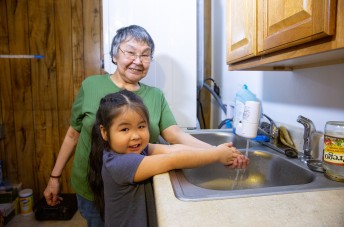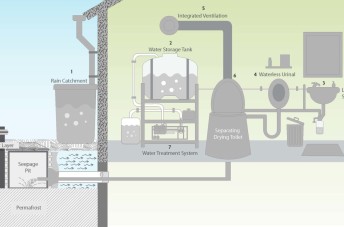Category: Healthy Homes and Communities
HRV filter maintenance during spring cleaning

As spring is in bloom, many people are taking care of their annual spring cleaning. While you are doing the spring clean, consider cleaning the filters and core in your heat recovery ventilator (HRV). The filters and core keep things like bugs, dust and odors from circulating in your home. Now is the time to wash or vacuum your filters in anticipation for the bug and dust-filled summer season. Without maintenance, your filters and core will not function properly. Follow ...

When Eek Elder, Elias Keyes, turned on his new faucet for the first time and watched the water flow down his sink, he saw his relative’s prophetic words come to life. “My grandfather used to say a time would come when we could push a button and everything would happen. Now, I see that it is,” Keyes said. “When I’m gone, I won’t have to worry about my grandchildren having safe water.” In March, workers on the project to bring ...

As ANTHC’s latest sanitation project in Angoon nears completion, critical infrastructure upgrades are beginning to improve quality of life for the whole community. Angoon’s new, custom-built septic tank and outfall pipe are up and running, diverting waste from sensitive areas previously impacted by deficiencies in the old system. Mabel Jack, a community Elder whose yard had suffered wastewater discharges for years, enjoys a clean property. Area birds that formerly fed in contaminated areas are no longer enticed by wastewater spills. ...

This story appeared in the Jan.-March edition of the Mukluk Telegraph. Healthy homes and communities are the foundation for improving the health of Alaska Native people. Rural communities lack adequate sources of water to meet health and hygiene needs, and facilities that can safely dispose of their wastewater. Today, 33 Alaskan communities still use the honey bucket. For some of these communities, the possibility of eliminating the honey bucket and the health hazards that go with it seem to be ...

With help from the Alaska Native Tribal Health Consortium and Spruce Island Development Corporation, the City of Ouzinkie, a community just north of Kodiak, secured nearly $2 million from the U.S. Department of Agriculture (USDA) Rural Economic Development Loan and Grant Program and the U.S. Department of Housing and Urban Development (HUD) Community Development Block Grant (CDBG). CDBG grants are provided to help local governments tackle serious challenges facing their communities. In Ouzinkie’s case, the funding will help replace aging ...
Tips to maintain a healthy woodstove

With cold weather encouraging people to stay inside near a warm fire, now is a good time to think about how the proper maintenance of our woodstoves can protect our safety and health, as well as the longevity of the stove. It’s important to keep tabs on what you are burning and how it burns. For instance, a black, soot-filled window on your woodstove can be an indication that maintenance is needed, or burning practices need to be changed. A ...
